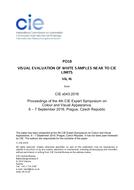Description
The evaluation of whiteness of a product is dependent from the materials and the application it is used in. Natural materials for example tend to yield some yellowish tint e.g. cotton or wool, so the industry modifies the materials to compensate for this effect (yellowish tint of a product is most often seen as a quality flaw, e.g. yellowed due to aging or dirt) and make the appearance of a product whiter. The intuitive interpretation of paper whiteness is a material with high light reflection for all wavelengths in the visual part of the colour spectrum. However, a slightly bluish shade is perceived as being whiter than a neutral white. Fluorescent Whitening Agents (FWA), dyes and pigmented inks are used extensively in the textile, pulp and paper industry. It was found that in some cases, calculated CIE whiteness values increased with increasing amount of colours in the whitened substrate appeared darker or redder to the observers. Small deviations in measured CIE tristimulus functions X, Y, and Z often caused significant changes in calculated CIE, and Ganz whiteness values. A visual assessment study of the selected samples was carried out in order to relate the influence of the high tint to perceive white. The results show the deficiencies in the current measurement techniques for assessment of brightness and whiteness of textile fabrics containing optical brightening agents.
Product Details
- Published:
- 09/01/2016
- Number of Pages:
- 9
- File Size:
- 1 file , 1 MB
- Product Code(s):
- x043-PO18, x043-PO18, x043-PO18
